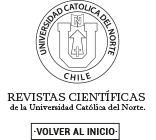Dimorfismo sexual, distribución etaria y longevidad del cementerio Pica 8 (período Intermedio Tardío, 950-1450 DC, Norte Grande de Chile)
Keywords:
Complejo Pica Tarapacá, estimación de sexo, estimación de la edad de muerte, longevidad, Pica Tarapacá Complex, sex estimation, age at death assessment, longevity.Abstract
El objetivo de este trabajo fue estudiar la distribución por sexo, edad y longevidad de los individuos adultos de la colección esqueletal cementerio Pica 8 (82 individuos), perteneciente al Complejo Pica Tarapacá, Norte Grande de Chile. Respecto al sexo, se utilizaron los métodos de Buikstra y colaboradores para coxales y Ferembach y colaboradores para el cráneo, con lo que se pudo estimar el sexo de toda la muestra (35 masculinos; 47 femeninos). Respecto a la estimación de la edad, se utilizaron los métodos de Brooks y Suchey para la sínfisis púbica y Lovejoy para la superficie auricular del ilion. Éstos presentaron estimaciones similares hasta los 39 años, pero difirieron posteriormente. Se discute la presencia de individuos seniles en este Complejo Cultural, ya que abre interesantes interrogantes sobre su rol cultural. En este sentido, es importante complementar la investigación, utilizando una visión desde la paleogerontología y en general, una visión a partir de la antropología de las edades, que podría contribuir más a la comprensión de este Complejo Cultural.
The aim of this paper was to study the age, sex and longevity distributions of adult skeletons from Pica 8 skeletal collection (82 skeletons), belonging to the Pica Tarapacá Complex, Northern Chile. Regarding sex estimation, we utilized Buikstra and colleagues’ method for the os coxae bone and Ferembach and colleagues’ method for cranial estimation was utilized. With these methods sex was estimated for all the sample (35 males, 47 females). Concerning age estimation, Brooks and Suchey method for pubic symphysis and Lovejoy method for iliac auricular surface were utilized. Both methods showed similar estimations until 39 years old, but differed beyond this age. The presence of senile individuals in this cultural complex is discussed as it opens interesting venues of research about their cultural role. In this sense, it is important to complement the research with a paleo gerontologic focus and in general, a focus from the Anthropology of Aging, which could contribute more to understanding of this cultural complex.
Downloads
Downloads
Published
Issue
Section
License

All works published in Revista Estudios Atacameños (ISSN on line:0718-1043) Revista Estudios Atacameños Creative Commons International 4.0 attribution (CC BY 4.0) licence.
Authors remain the owners of their work and may republish their articles elsewhere without having to request permission, as long as they indicate that the work was originally published in Revista Estudios Atacameños (ISSN on liine:0718-1043).












